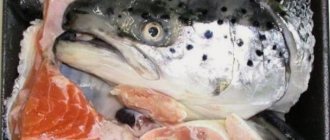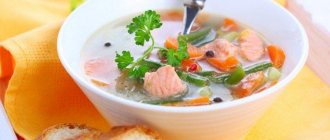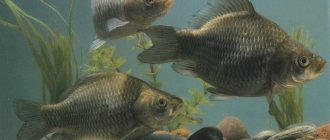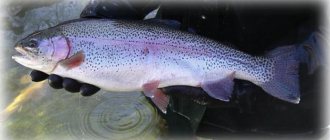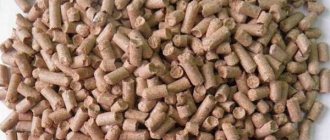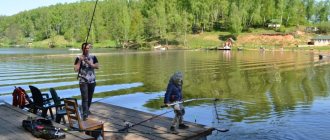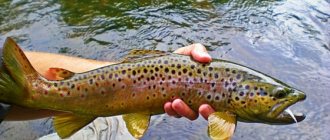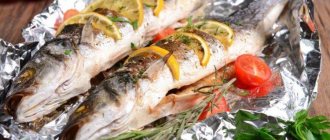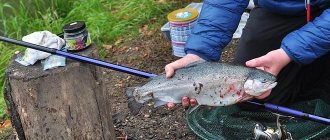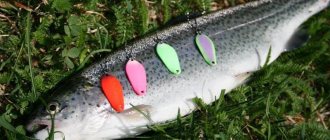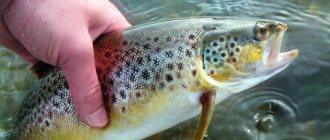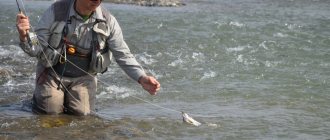Spawning
In special ponds, individuals prepare for spawning. The timing of this process depends on temperature, sunlight and other natural characteristics of the habitat. The fish typically lives from 3 to 5 years, and the sex ratio is 1 male to 5-10 females. Females and males that are ripe for reproduction are selected. Attention is paid to their body weight and health status. You can get about 2000 eggs from a female at a time. The quantity depends on the size of the individual (there are about 1500 eggs per kg of fish body weight).
Female rainbow trout reach sexual maturity at the age of 3 years, and males at 2 years. Spawning on farms continues from May to September.
Types of pond trout
There are 20 known varieties of this salmon fish. Two of them are most suitable for breeding - rainbow and brook. There are several reasons why these species are famous:
- excellent taste of the finished product;
- unpretentiousness in comparison with other salmonids;
- high productivity;
- feed availability;
- an established system for growing specifically these varieties.
Both trout are predators, but otherwise have many differences that must be taken into account when raising fish.
Interesting fact! Trout is rightly called “fast fish.” It moves in water twice as fast as other freshwater animals, reaching speeds of 16 km/h. Chased by a predator, the fish jumps out of the water at a speed of 30 km/h to a height of up to 2 meters.
Rainbow
Rainbow trout is native to North America. It received its name for its shiny silver scales, as well as for the bright iridescent stripe along the lateral line. This stripe is especially noticeable in males who have reached sexual maturity.
pixabay.com
Interesting to know! If there is abundant food in the reservoir, the trout may lack lateral stripes. And if you run it into another body of water, the stripes will appear again.
An advantage when breeding rainbow trout is considered to be early puberty (2-3 years). Females give birth to 800-3000 offspring. Spawning and incubation occurs in the spring. The disadvantage is the difficulty in stimulating reproduction. When breeding, artificial insemination is used.
Although the “iris” is a cold-water fish, it can grow quickly in warm ponds at +16-18°C. This temperature accelerates growth.
Rainbow trout coexists well with other representatives of the ichthyofauna, which is also important when breeding this species. The best subspecies of the “iris” are considered to be the Canadian Kamloops, as well as Donaldson’s trout. They are highly productive and are famous for their fast growth rate.
Ruchevaya
In their natural environment, brook trout can be seen in mountain rivers that flow into the Baltic, Black and Caspian Seas. Because of the beautiful colors of its scales, it was nicknamed “speckled”. In nature, an adult specimen is found at the age of 12 years and weighing up to 12 kg.
The tender dietary trout meat of this species is highly valued. The growth rate of brook trout is one level lower than that of rainbow trout and depends on high-quality complementary feeding, adherence to temperature conditions and technology.
Important! Trout meat is rich in phosphorus and polyunsaturated fatty acids. Scientists have noted that people are less stressed and melancholy if they eat red fish.
The fertility of the "pied" depends on the size of the female, which on average produces up to 1,500 eggs. This species spawns from October to January at 3-4 years of age. The eggs reach 7 mm in diameter. At a water temperature of +2°C, the incubation period takes 200 days. If you raise it to +8°C, the period can be reduced to 2 months.
pixabay.com
Development of fry
Egg development takes place in incubators. These are rooms in which special devices are located, where acceptable environmental conditions are maintained.
Farms use various incubators. Any of them supplies a sufficient amount of oxygenated, clean water free of suspended solids and contaminants. Plaque in a dirty environment surrounds the eggs, depriving them of oxygen, and also creates ideal conditions for the development of pathogens. For this reason, the composition of trout feed is selected in such a way that it does not settle in the water.
It is worth paying attention to the speed of the water flowing among the fertilized eggs. A flow that is too slow results in insufficient oxygenation, while a flow that is too fast can cause turbulence, which interferes with the development of the eggs. Each of the devices has a lid that protects the eggs from direct light.
The duration of incubation depends on the water temperature. Maintaining a temperature of 4 to 10°C allows you to get fry after 34 days.
Growing cycle and technology
Growing trout takes quite a long time. In order for the fry to grow to the size of an adult fish within a few years, it is necessary to create suitable conditions. The equipment used for trout farming is also suitable for other types of fish. The difference lies in the unique conditions. To do this, it is recommended to first study the features of the natural environment in which the trout lives.
Suitable water chemistry for keeping trout includes the following standards:
- oxygen level - from 7 to 11 milligrams per liter (the necessary indicator will be provided by the aeration column);
- pH value – not lower than 6.5 and not higher than 8 (if it falls below the permissible norm, the fish stops reproducing; if it rises higher, the trout may die);
- nitrate concentration – up to 100 milligrams per liter (above this value poses a risk to fish);
- ammonia level - 0.1 milligrams per liter;
- hardness index – from 8 to 12;
- carbon dioxide content – up to 35 milligrams per liter;
- chlorine level – up to 0.01 milligrams per liter.
To check chemical indicators, special devices are used, which can be purchased at hardware stores.
Feeding fry and adult fish
Proper feeding determines how long it will take for the fry to grow to the size of an adult, and how tasty the fish will be. There are two types of trout food: organic and dry. Fish tastes better if the first type is used.
To give fish meat a red color, canthaxanthin should be added to the food.
Feeding of fry and adult fish is different. You should start feeding trout from the moment it is born. The diet for fry consists of:
- zooplankton (egg yolk may be added);
- meat and fish flour;
- fish oil.
You can prepare a mash by combining different feed options. The optimal number of feedings per day should not exceed 9 times. A thousand individuals require about 90 grams of food. There is a special floating and sinking type food available for sale that simplifies feeding.
Adults can be given dry and live food. The ratio of these species is divided approximately equally with a bias in favor of living species. The diet for adult fish consists of:
- chopped animal meat;
- fish waste;
- shrimp;
- water snails;
- insects
Fiber is also used to feed fish. It does not provide any benefit to the trout, but it loosens other types of food, making them better digestible.
Temperature
In a body of natural origin, it is difficult to regulate the temperature. Therefore, it is recommended to keep trout in a RAS. Depending on the age, the following indicators are suitable for this type of fish:
- from +6 to +12 degrees Celsius – for the ripening of caviar;
- from +10 to +14 degrees Celsius – for fry;
- from +14 to +16 degrees Celsius – for adult fish.
The temperature gradually rises as the trout grow.
Care and cultivation standards
In order for trout to develop well, you need to follow a number of tips. The water must have the right temperature and sufficient oxygen. It is necessary to check the serviceability of filters - water contamination can harm the fish.
It is recommended to separate small and large fish by placing them in separate containers. Thanks to this method, weak individuals will get more food and they will grow faster. During the spawning period, the best individuals should be selected to produce offspring.
With normal development, the weight of rainbow trout is:
- 30 grams – at the age of fry;
- 125 grams – one-year-old individuals;
- 200 grams – fish over two years old.
Brown trout develop more slowly, so the indicated indicators for it are lower at the same age.
Feeding the fry
Fry from incubators and cable trays are moved to a new environment. At this stage, trout weighing at least 40 grams are selected. Food for trout fry should be balanced. Most often, offspring appear in early spring.
After reaching a certain body weight, the fry are transferred to new containers. There they are kept until their weight reaches 200-500 grams. The entire production cycle lasts two years.
Digging pond from the perspective of water legislation
To properly understand the issue, it is necessary to define the terminology.
According to clause 4 of Art. 1 of the Water Code of the Russian Federation (hereinafter referred to as the Water Code of the Russian Federation), a water body is a natural or artificial reservoir, watercourse or other object, the permanent or temporary concentration of water in which has characteristic forms and characteristics of the water regime.
Clause 3, Part 2, Art. 5 of the Water Code of the Russian Federation provides a closed list of reservoirs - lakes, ponds, flooded quarries, reservoirs.
The terms pond and reservoir are given in GOST 19179-73 “Hydrology of land. Terms and definitions" (hereinafter referred to as GOST 19179-73), which establishes the terms and definitions of basic concepts in the field of land hydrology used in science, technology and production. GOST 19179-73 gives the following terms:
— A reservoir is a body of water in a depression of land, characterized by slow movement of water or its complete absence. There are natural reservoirs, which are natural accumulations of water in depressions, and artificial reservoirs, which are specially created accumulations of water in artificial or natural depressions of the earth's surface;
— Reservoir - an artificial reservoir formed by a water-retaining structure on a watercourse for the purpose of storing water and regulating flow;
— A pond is a shallow water reservoir with an area of no more than 1 sq. km.
Based on the terms given in GOST 19179-73, a pond is a shallow artificial reservoir formed by a water-retaining structure on a watercourse for the purpose of storing water and regulating flow with an area of no more than 1 square. km.
GOST 19179-73 also gives the concept of “Pond-dig” - a small artificial reservoir in a specially dug depression on the surface of the earth, intended for the accumulation and storage of water for various economic purposes.
In practice, there are different classifications of ponds.
By origin it is customary to distinguish:
- dug reservoirs (digging ponds)
- created by blocking a permanent or temporary watercourse with a dam (river ponds).
Depending on the purpose, there are cooling ponds, settling ponds, storage ponds, evaporation ponds, etc.
Thus:
POND is a shallow artificial reservoir formed by a water-retaining structure on a watercourse or in a specially dug depression on the surface of the earth, intended for the accumulation and storage of water for various economic purposes with an area of no more than 1 square. km.
Where they fatten
Trout are fed in longitudinal ponds measuring 25x5 m with a depth of more than a meter. The inflow and outflow are protected by a fine mesh, which does not allow fish to escape. The mesh must be cleaned frequently, as algae and leaves settle on it, which impedes the flow of fresh, oxygenated water.
Sometimes this type of fish is bred directly in a flowing river or source; only nets are installed to prevent the fish from escaping. This type of solution does not guarantee adequate trout quality and may also pose a safety hazard in the event of intensive production. There are fish farming cooperatives focused on breeding trout only of a certain age. However, the greatest efficiency is observed in farms specializing in the production of fish at all stages of its development.
Where to grow trout - breeding at home
Before you start your business, you must first prepare everything necessary for raising individuals. Fish farming requires certain costs and equipment, so first review the necessary elements and food for trout.
First of all, fish of this type love cool water within 16-18 degrees. In this temperature range they feed well and gain height and weight. At the same time, they grow quite quickly and reproduce easily, which cannot be said about sturgeons. A female can produce up to 3 thousand eggs at a time, and individuals reach a weight of half a kilo. Many farmers breed both types of trout at once, but keep them in separate reservoirs. Brook trout are hatched in the fall, while rainbow trout are hatched in the spring.
It can be grown in a pond, pool and RAS. More natural bodies of water are still considered the most optimal in terms of conditions, since the RAS is too crowded for these types of fish.
The video shows all the ways to grow trout:
Pond cultivation technology - how to breed
The pond can be either natural or artificial. For a natural one, the reservoir will have to be prepared to receive fry. In this case, it is necessary to do high-quality cleaning, preparing for stocking. It is worth noting that there are many problems with this type of breeding site - not only in terms of preparation, but also simply in creating the most optimal living conditions, as well as in the fight against poachers. In general, you will need to organize an artificial reservoir:
- Pump systems;
- Water filtration system;
- Feed supply.
Therefore, it is recommended to create an artificial pond. To do this, either take a plastic bowl or make a corresponding base in the ground. The cage option for breeding is unacceptable. You can also prepare a pool for this. The pool will require the same equipment, but with the corresponding indicators.
It is necessary to select equipment according to the displacement that it is capable of processing. Ideally, the indicators should be slightly higher so that the elements do not wear out too quickly when operating at the limit.
How to grow in RAS equipment
Trout is a more delicate type of fish and has its own requirements in a body of water. In particular, these requirements affect temperature indicators and volumes for robbing. For trout to function normally, the depth of the reservoir must be at least 10 meters, and the temperature must be 15-19 degrees. An increase in these indicators can lead to the death of individuals, and therefore conditions should be maintained throughout the entire growing period.
Accordingly, it is quite difficult to create such optimal conditions with closed-type installations. This is why many people abandon this type of fish in favor of others. At the same time, trout still has greater productivity, and the meat is more expensive.
In the video - growing trout in a RAS:
Nutrition
The composition of trout feed must be balanced. It satisfies the fish's demand for components such as protein, fat, carbohydrates, minerals and vitamins. Trout fish food in granular form of animal origin is especially popular. We are talking about meat, offal and animal fat. It is also common to use starter feeds for trout based on flour, wheat bran, and yeast.
When determining the dosage, it is necessary to take into account factors such as water temperature, body weight of fish, oxygen content in water, and water pH. The quality of food for trout plays a big role.
An important factor influencing growth rates is the frequency of feeding. The younger the fish, the more often you need to feed it. After birth, the fry need to be given food every half hour. For older trout, food may be provided twice daily. Feeding can be done manually or mechanically using special automatic machines. The advantage of automatically feeding trout feed is that it reduces time and labor. The disadvantage is limited control over the health of the fish.
Automated trout feeding
Figure 1: Feeding device used in trout production. Several types of automatic and mechanical feeders are available for trout farming, including electric ones with timers. There are feeders that use compressed air to blow through the surface of the water at set intervals, as well as truck or trailer mounted units that have hydraulic air delivery devices.
By carefully setting trout feeders, rapid weight gain and efficient feed utilization can be achieved. The use of food feeders can eliminate the sudden decrease in oxygen that occurs when fish are fed by hand or machine several times a day. Food feeders also reduce the labor costs associated with daily manual feeding. Disadvantages include a tendency to overfeed due to improper feed adjustments and food output only in a small part of the pond or tank. Overloading feed with nutritional demand can be a problem with large trout.
Food feeders should be located at intervals of 1 meter along the walls of the tank. After a few days the feed can be added, but for best feeding efficiency it should not be replaced until the feeding period has passed. Adjust the feeder. Even if food feeders are used, for best performance it is recommended to feed according to the feed chart. Whether fed by hand or using a mechanical distribution system, the feed should be distributed throughout the entire pond and should not accumulate on the bottom. In concrete tanks, trout will feed on some of the pellets that fall to the bottom, but trout rarely pick up pellets from the bottom of ponds.
Live food for trout
Live food feeding is very popular. It has many benefits for trout. This is a natural way of feeding fish and increases its vitality. Providing a balanced and satisfying diet is very important. The range of live food is quite large, but choosing the right food is not always easy. For example, red mosquito larvae are often used for this purpose. They have a characteristic red color, which is due to the oxygen content. Fish love this food, and thanks to its red color they immediately notice it. The larvae can be stored in a cool place for one to two weeks.
Comparative analysis of reservoirs
Minorca: characteristics of the breed, conditions for keeping chickens
Three methods of trout breeding have been invented, differing in the type of pool chosen.
open pond
The method is not used in professional fish farms, but is more suitable for those who raise trout in the country. You will need to find or dig a pond. In cold conditions, it will take about 5 years to grow until marketable.
There is a high risk of population decline due to disease and poachers. To reduce the influence of negative factors in such cases, specially trained people are hired to handle both housekeeping and security. An open pond is the most energy- and resource-intensive method and does not justify the investment. You can grow fish, but the cost will be much higher than buying the delicacy in a store.
cages
This technology allows you to raise a flock in a fenced area of the reservoir. Cages are a rigid frame made of stakes, wooden boxes or metal parts, on which a net is stretched. A flock lives and feeds in it.
- Saving pond space. In unused territory you can organize paid fishing.
- The cages are located in the pond, and only technical buildings are erected on the shore: houses, warehouses, etc.
- The costs of constructing hydraulic structures are several times lower.
- In the cages there is a natural exchange of water due to the movement of the school, springs and waves.
Among the disadvantages, it is noted that with a significant planting density, pollution of the reservoir with organic waste occurs (eutrophication). Therefore, fish are grown in cages where the selected area does not serve as a source of drinking water.
Additional protection from poachers will be required. Some businessmen install fences and watchmen, some solve the problem by installing video surveillance, and some combine available methods, increasing the cost of doing business.
RAS
Recirculated water supply installations have become a common technology for artificial breeding of trout in ponds. The method allows you to quickly and efficiently breed healthy large fish at home. Among the disadvantages, there is a large starting capital, which ultimately pays off with a profit.
The RAS principle is based on the water cycle with artificially set optimal life support parameters.
The kit includes:
- pools with a smooth surface without sharp corners;
- ozonation system;
- oxygen generator;
- emergency air duct;
- pump;
- filter;
- pool adder, etc.
- The desired temperature is maintained, regardless of the vagaries of the weather.
- Maintenance and breeding are under total control.
- Environmentally friendly production.
For 1 kilogram of the resulting product, there are from 100 to 500 liters of water, which is an economical development.
Full automation of processes has made the question of how to breed trout an expensive but profitable business.
Additional recommendations
Today, trout are bred, as a rule, in swimming pools, natural reservoirs and in special systems created artificially. It is important that the fish receive a balanced diet. This directly affects the speed of its development. Trout is a predator. Special feed mixtures are used for her. They definitely contain carotene. It is noteworthy that initially the meat of this fish does not have a reddish tint - it is this element that colors it.
As a rule, food is used wet or dry. Granular is popular among breeders. To gain 1 kg of fish weight, about 2 kg of dry food is required. If we are talking about wet food, about 6 kg is required. Moreover, even effective feeding does not bring much results if there are no suitable circumstances. It is necessary that the water has a sufficient concentration of oxygen.
Typically, imported feed costs about $2 per 1 kg. About a day, one adult eats food in the amount of 10% of its body weight. However, this indicator is directly influenced by the conditions of its detention. Contrary to popular belief, it is dangerous to feed trout too much food. This may cause her growth to slow down. It is most profitable to breed one-year-old fish whose weight exceeds 250 g. Young fish need to be fed about seven times a day, and adults - no more than 4 times a day.
It is worth considering that this fish adapts very well to various conditions. Depending on the environment, it can change its color. Not only in different waters, but also in the same stream, you can find fish that differ in color from others. Trout are often raised in artificial reservoirs because only about 10% of the fry survive in the natural environment.
Reproduction in the natural environment occurs in the spring, but in fish farms it can occur all year round.
To select food, it is necessary to take into account the conditions in which this type of fish is bred. It is recommended to use fish meal (up to 50% of the diet), as well as milk (skimmed, dry), blood or bone meal. Trout should consume a lot of protein, especially juveniles. In blood meal, this component is not completely complete, which breeders need to take into account.
In addition, you can add cake and meal (flaxseed, sunflower, etc.) to fish feed. However, it is not recommended to give her cotton meal due to the presence of toxic impurities in it. It is imperative to add feed yeast to the diet, which is a source of many vitamins.
What to feed - nutritional standards, composition and recipes of feed
Naturally, the main expenses are associated with the purchase of necessary food for individuals. Trout's diet is much more expensive than that of carp. For 1 kg of feed you will have to pay about 1 dollar. You may also be interested in information about what the composition of feed for rabbits at home should be.
Ready-made feed for fish farming and their prices
Trout prefers live food. The fry do not mind swallowing squid larvae, flies, dragonflies, and beetles. As they grow older, they can switch to smaller types of fish. This can be found either from fishing store suppliers or from farming businesses. There are:
- Starter feed for fry and young animals weighing up to 5 g;
- Adults from 5 years.
Trout also like to eat dry food. It has the form of granules, which make it possible to adjust the dose of food. It can be stored for about a year in a dry and warm place. It is worth considering that young animals eat about 10 times a day, but fish that are 5-8 months old already eat about 6 times a day. One-year-old individuals – 3 times. But in the latter case, the food consists of live food and a dough-like mixture.
The video shows the process of feeding trout:
It is also impossible to overfeed trout, since this type of fish is prone to obesity. And this, in turn, inhibits the development of the individual. Therefore, the diet must be given in doses and extremely carefully.
But what the diet for feeding turkeys for meat should be, the information at the link will help you understand.
How to make compound feed with your own hands for feeding and growing fish on a farm in a lake or country house
Artificial feed consists of:
- Protein – 40-45%;
- Fat – 7-15%;
- BEV – 20-25%;
- Fiber – up to 3%;
- Minerals – 10-15%.
Accordingly, the energy value is 12 thousand kJ per 1 kg of mixture. Such feed is produced from: fish meal, meat and bone meal, wheat meal and so on, as well as meal, yeast and many other elements. It is difficult to prepare a balanced mixture at home without losing quality.
It is better to raise young animals on wet food, while older animals can be safely transferred to dry food. When purchasing wet food, you should accurately calculate the exact volume of food so that it is enough for 1-2 times, since this type of food quickly deteriorates.
The composition of a homemade mixture for fry usually includes:
- Fishmeal, which is made from freshly caught fish;
- Saccharins and saccharides;
- Wheat and corn glutens;
- Amino acids;
- Vitamins.
